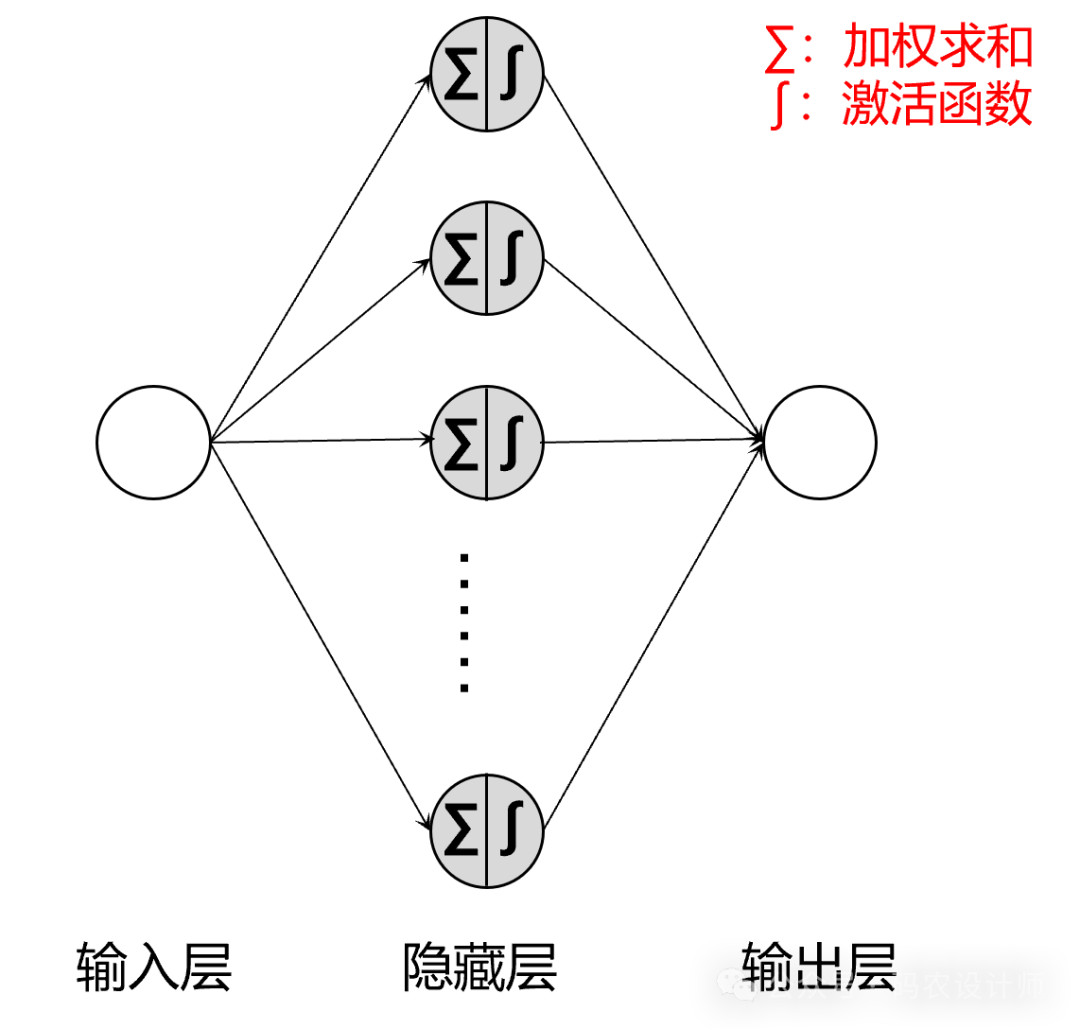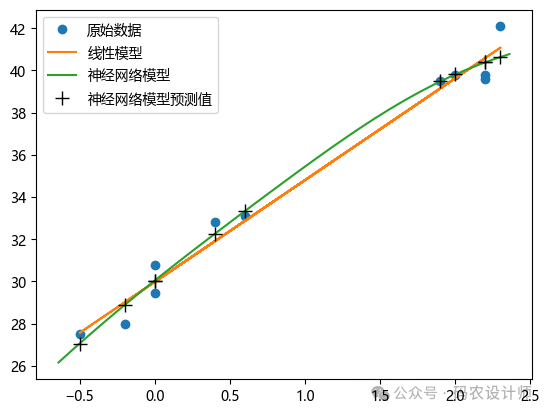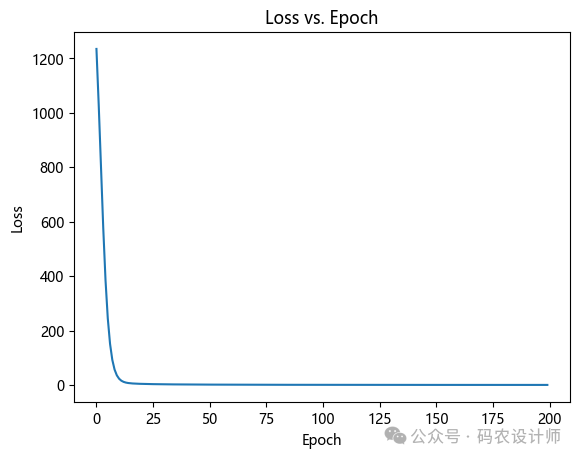本系列文章配套代码获取有以下两种途径:
-
通过百度网盘获取:
链接:https://pan.baidu.com/s/1XuxKa9_G00NznvSK0cr5qw?pwd=mnsj提取码:mnsj
-
前往GitHub获取:
https://github.com/returu/PyTorch

神经网络搭建:
# 神经网络模型
>>> model_1 = nn.Sequential(
... nn.Linear(1,13),
... nn.Tanh(),
... nn.Linear(13,1)
... )
>>> model_1
Sequential(
(0): Linear(in_features=1, out_features=13, bias=True)
(1): Tanh()
(2): Linear(in_features=13, out_features=1, bias=True)
)
>>> for param in model_1.parameters():
... print(param.shape)
...
torch.Size([13, 1])
torch.Size([13])
torch.Size([1, 13])
torch.Size([1])
>>> for name,param in model_1.named_parameters():
... print(name , '-->',param.shape)
...
0.weight --> torch.Size([13, 1])
0.bias --> torch.Size([13])
2.weight --> torch.Size([1, 13])
2.bias --> torch.Size([1])
>>> from collections import OrderedDict
# 神经网络模型
>>> model_2 = nn.Sequential(OrderedDict([
... ('hidden_layer' , nn.Linear(1,13)) ,
... ('hidden_activation' , nn.Tanh()) ,
... ('output_layer' , nn.Linear(13,1))])
... )
>>> model_2
Sequential(
(hidden_layer): Linear(in_features=1, out_features=13, bias=True)
(hidden_activation): Tanh()
(output_layer): Linear(in_features=13, out_features=1, bias=True)
)
>>> for name,param in model_2.named_parameters():
... print(name , '-->',param.shape)
...
hidden_layer.weight --> torch.Size([13, 1])
hidden_layer.bias --> torch.Size([13])
output_layer.weight --> torch.Size([1, 13])
output_layer.bias --> torch.Size([1])
# 通过子模块作为属性来访问一个特定的参数
>>> model_2.hidden_layer.bias
Parameter containing:
tensor([-0.9065, -0.8778, 0.9589, -0.8350, 0.4945, -0.0443, -0.9624, 0.8843,
-0.4794, 0.0036, -0.7114, -0.6724, -0.7271], requires_grad=True)
# 未进行反向传播,因此梯度为None
>>> model_2.hidden_layer.bias.grad
>>> print(model_2.hidden_layer.bias.grad)
None
使用神经网络替换线性模型:
-
生成数据:
# 设置随机数种子,保证运行结果一致
torch.manual_seed(2024)
def get_fake_data(num):
"""
生成随机数据,y = 0.5 * x +30并加上一些随机噪声
"""
x = torch.randint(low = -5, high=30, size=(num,)).to(dtype=torch.float32)
y = 0.5 * x +30 + torch.randn(num,)
return x,y
x , y = get_fake_data(num=11)
x = x * 0.1
# 增加batch维度
x = x.unsqueeze(1)
y = y.unsqueeze(1)
-
定义函数:
# 神经网络模型
seq_model = nn.Sequential(OrderedDict([
('hidden_layer' , nn.Linear(1,13)) ,
('hidden_activation' , nn.Tanh()) ,
('output_layer' , nn.Linear(13,1))])
)
# 定义损失函数
loss_fn = nn.MSELoss()
# 实例化一个优化器
learning_rate=1e-2
optimizer = torch.optim.SGD(seq_model.parameters() , lr=learning_rate)
-
循环训练,求解参数值:
from IPython import display
# 设置全局字体
plt.rcParams["font.sans-serif"] = "Microsoft YaHei"
def training_loop(n_epochs , optimizer , model , loss_fn , x , y):
# 记录损失的列表
losses = []
for epoch in range(1 , n_epochs+1):
#前向传播
y_p = model(x)
loss = loss_fn(y_p ,y)
# 梯度归零
optimizer.zero_grad()
# 反向传播
loss.backward()
# 参数更新
optimizer.step()
# 记录损失
losses.append(loss.item())
if epoch % 10 ==0:
display.clear_output(wait=True)
# 原始数据
plt.plot(x , y , 'o' , label="原始数据")
# 线性模型
plt.plot(x , (4.827*x+29.977) , label="线性模型")
# 获取xy轴的范围
xmin,xmax,ymin,ymax = plt.axis()
# 输入,模型预测值
plt.plot(torch.arange(xmin , xmax , 0.1).numpy() , model(torch.arange(xmin , xmax , 0.1).unsqueeze(1)).detach().numpy() , '-' , label="神经网络模型")
plt.plot(x.detach().numpy() , y_p.detach().numpy() , 'k+' ,markersize=10 , label="神经网络模型预测值")
plt.legend()
plt.show()
plt.pause(0.5)
return losses
losses = training_loop(n_epochs=200 , optimizer=optimizer , model=seq_model , loss_fn=loss_fn , x=x , y=y)

-
可视化损失:
plt.plot(range(200), losses)
plt.xlabel('Epoch')
plt.ylabel('Loss')
plt.title('Loss vs. Epoch')
plt.show()

更多内容可以前往官网查看:
https://pytorch.org/


本篇文章来源于微信公众号: 码农设计师
